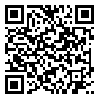Volume 13, Issue 5 (Dec & Jan 2020)
payavard 2020, 13(5): 411-418 |
Back to browse issues page
Download citation:
BibTeX | RIS | EndNote | Medlars | ProCite | Reference Manager | RefWorks
Send citation to:



BibTeX | RIS | EndNote | Medlars | ProCite | Reference Manager | RefWorks
Send citation to:
Soltan Dallal M M, Zandieh Moradi R, Mazaheri Nezhad Fard R, Rajabi Z. Identification and Diagnosis of Enterohemorrhagic E. Coli by Molecular Method in Boroujerd City Cows' Milk. payavard 2020; 13 (5) :411-418
URL: http://payavard.tums.ac.ir/article-1-6926-en.html
URL: http://payavard.tums.ac.ir/article-1-6926-en.html
Mohammad Mehdi Soltan Dallal * 
 1, Reza Zandieh Moradi2
1, Reza Zandieh Moradi2 
 , Ramin Mazaheri Nezhad Fard3
, Ramin Mazaheri Nezhad Fard3 
 , Zahra Rajabi4
, Zahra Rajabi4 


 1, Reza Zandieh Moradi2
1, Reza Zandieh Moradi2 
 , Ramin Mazaheri Nezhad Fard3
, Ramin Mazaheri Nezhad Fard3 
 , Zahra Rajabi4
, Zahra Rajabi4 

1- Professor, Department of Pathobiology, Food Microbiology Research Center/Division of Food Microbiology, School of Public Health, Tehran University of Medical Sciences, Tehran, Iran , soltanda@sina.tums.ac.ir
2- Master of Science in Food Microbiology, School of Public Health, Tehran University of Medical Sciences, Tehran, Iran
3- Assistant Professor, Department of Pathobiology, Food Microbiology Research Center/Division of Food Microbiology, School of Public Health, Tehran University of Medical Sciences, Tehran, Iran
4- Master of Science in Microbiology, Food Microbiology Research Center, Tehran University of Medical Sciences, Tehran, Iran
2- Master of Science in Food Microbiology, School of Public Health, Tehran University of Medical Sciences, Tehran, Iran
3- Assistant Professor, Department of Pathobiology, Food Microbiology Research Center/Division of Food Microbiology, School of Public Health, Tehran University of Medical Sciences, Tehran, Iran
4- Master of Science in Microbiology, Food Microbiology Research Center, Tehran University of Medical Sciences, Tehran, Iran
Abstract: (1947 Views)
Background and Aim: Transmission of pathogenic bacteria from animals to humans is possible directly or through the consumption of meat and milk or their products. The aim of this study was to identify and diagnose Enterohemorrhagic Escherichia coli (E. coli) by molecular method in cows' milk in Boroujerd city.
Materials and Methods: In a descriptive cross-sectional study, 150 milk samples were sampled from dairy farms in Boroujerd and its suburbs in four months from the beginning of November 2016 until the end of February 2017. After enrichment, culturing and biochemical tests on EMB agar and IMVIC differential tests, and doing linear culture on Sorbitol McConkey Agar medium to identify negative sorbitol isolates and confirm them by serological testing and eaeA gene identification, milk samples were analyzed by PCR test.
Results: Out of 31 isolates of Escherichia coli species, 6 were isolated as negative sorbitol (19.4%). Of these six isolates, five (16.1%) were identified as negative beta-galactosidase (MUG-) on chrome agar medium. In serological test, all 5 isolates were confirmed by O157: H7 antiserum antibody; besides, in molecular analysis, they had eaeA gene.
Conclusion: The outbreak of 16.1% of enterohemorrhagic E. coli in milk can be of great importance as one of the factors causing diarrhea in the community. Therefore, the outbreaks of consumption of this foodstuff in areas of the country that traditionally still put raw milk in food basket can provide valuable results for the prevention of diarrheal diseases.
Materials and Methods: In a descriptive cross-sectional study, 150 milk samples were sampled from dairy farms in Boroujerd and its suburbs in four months from the beginning of November 2016 until the end of February 2017. After enrichment, culturing and biochemical tests on EMB agar and IMVIC differential tests, and doing linear culture on Sorbitol McConkey Agar medium to identify negative sorbitol isolates and confirm them by serological testing and eaeA gene identification, milk samples were analyzed by PCR test.
Results: Out of 31 isolates of Escherichia coli species, 6 were isolated as negative sorbitol (19.4%). Of these six isolates, five (16.1%) were identified as negative beta-galactosidase (MUG-) on chrome agar medium. In serological test, all 5 isolates were confirmed by O157: H7 antiserum antibody; besides, in molecular analysis, they had eaeA gene.
Conclusion: The outbreak of 16.1% of enterohemorrhagic E. coli in milk can be of great importance as one of the factors causing diarrhea in the community. Therefore, the outbreaks of consumption of this foodstuff in areas of the country that traditionally still put raw milk in food basket can provide valuable results for the prevention of diarrheal diseases.
Send email to the article author
| Rights and permissions | |
 |
This work is licensed under a Creative Commons Attribution-NonCommercial 4.0 International License. |



